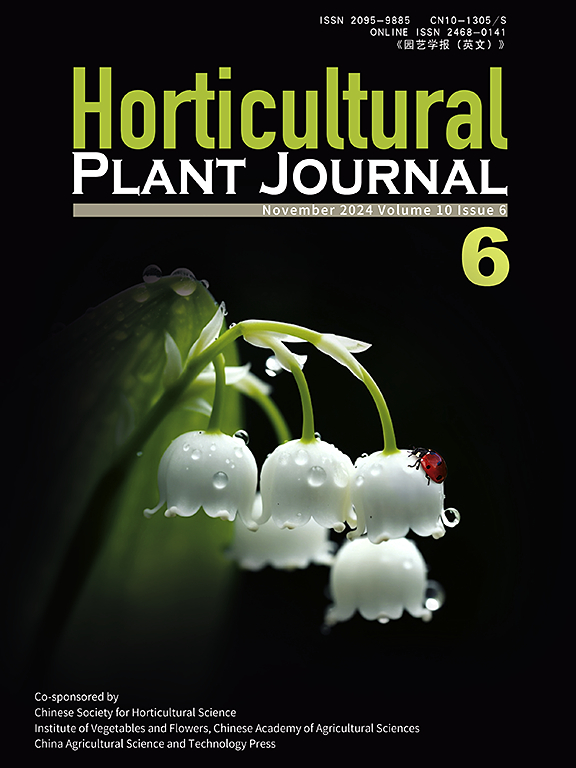CsCit和CsALMT9-like表达的升高在降柠檬酸和增加苹果酸积累中起关键作用
IF 6.2
1区 农林科学
Q1 HORTICULTURE
引用次数: 0
摘要
有机酸组成对水果的口感和品质有重要影响。一般来说,普通柑橘品种的果实中积累的柠檬酸盐多于苹果酸盐。在这里,我们报道了一个柑橘品种,‘ Haruka ’ (citrus tamurana × natsudaidai),在成熟阶段积累了比柠檬酸更多的苹果酸。然而,潜在的机制尚不清楚。比较了“春香”果实与普通庞坎品种“华干2号”果实在发育和成熟过程中的有机酸谱。结果表明,‘春香’果实积累的柠檬酸盐比‘花干2号’果实少75%,苹果酸盐含量比‘花干2号’果实高近3倍。此外,在柑橘基因组中鉴定出12个铝活化苹果酸转运蛋白(ALMT)基因,其中csalmt9样基因主要表达在“Haruka”果汁囊中。对苹果酸积累相关基因的分析表明,编码p型质子泵(CsPH8)、柠檬酸盐/H+同调体(CsCit)和csalmt9样基因的表达水平在“榛果”果实中显著高于“花干2号”果实。此外,CsCit过表达显著降低了柠檬酸盐含量,而csalmt9样过表达和沉默显著增加和降低了苹果酸盐含量。遮荫处理显著提高了CsPH8的表达,但降低了CsCit和CsALMT9-like的表达;显著提高了柠檬酸盐含量,但降低了苹果酸盐含量,进一步证实了CsCit和CsALMT9-like分别调控了‘小香’果实中柠檬酸盐和苹果酸盐的积累。综上所述,这些数据表明,‘Haruka’相对较低的柠檬酸盐含量主要是由于CsCit表达的增加,而‘Haruka’相对较高的苹果酸盐含量主要是由于csalmt9样表达的增加。本研究为影响柑橘类水果中苹果酸含量的机制提供了深入的见解。本文章由计算机程序翻译,如有差异,请以英文原文为准。
Elevated expression of CsCit and CsALMT9-like plays a key role in lowering citrate and increasing malate accumulation in Citrus tamurana × natsudaidai ‘Haruka’ fruit
Organic acid composition has a major influence on fruit taste and quality. In general, the fruits of common citrus varieties accumulate more citrate than malate. Here, we report that a citrus variety, ‘Haruka’ (Citrus tamurana × natsudaidai ), accumulates more malate than citrate at the ripening stage. However, the underlying mechanism is unclear. Organic acid profiles were compared between ‘Haruka’ fruits and a common Ponkan cultivar, ‘Huagan 2’ (Citrus reticulata ), during fruit development and ripening. We found that ‘Haruka’ fruit accumulated 75 % less citrate than ‘Huagan 2’ fruit and that the malate content was nearly 3-fold greater in ‘Haruka’ fruit than in ‘Huagan 2’ fruit. In addition, 12 aluminum-activated malate transporter (ALMT ) genes were identified in the citrus genome, with CsALMT9-like being predominantly expressed in ‘Haruka’ fruit juice sacs. An analysis of genes associated with the accumulation of malate revealed that the expression levels of genes encoding a P-type proton pump (CsPH8 ), a citrate/H+ symporter (CsCit ), and CsALMT9-like were significantly greater in ‘Haruka’ fruit than in ‘Huagan 2’ fruit. Moreover, CsCit overexpression significantly decreased the citrate content, whereas overexpressing and silencing CsALMT9-like significantly increased and decreased the malate content. In addition, shading significantly increased the expression of CsPH8 but reduced the expression of CsCit and CsALMT9-like and significantly increased the citrate content but decreased the malate content, further confirming that CsCit and CsALMT9-like regulate the accumulation of citrate and malate in ‘Haruka’ fruit, respectively. Taken together, these data indicate that the relatively low citrate content of ‘Haruka’ is mainly due to increases in CsCit expression and that the relatively high malate content of ‘Haruka’ is mainly due to increases in CsALMT9 -like expression. This study provides insight into the mechanisms that influence malate content in citrus fruit.
求助全文
通过发布文献求助,成功后即可免费获取论文全文。
去求助
来源期刊

Horticultural Plant Journal
Environmental Science-Ecology
CiteScore
9.60
自引率
14.00%
发文量
293
审稿时长
33 weeks
期刊介绍:
Horticultural Plant Journal (HPJ) is an OPEN ACCESS international journal. HPJ publishes research related to all horticultural plants, including fruits, vegetables, ornamental plants, tea plants, and medicinal plants, etc. The journal covers all aspects of horticultural crop sciences, including germplasm resources, genetics and breeding, tillage and cultivation, physiology and biochemistry, ecology, genomics, biotechnology, plant protection, postharvest processing, etc. Article types include Original research papers, Reviews, and Short communications.
 求助内容:
求助内容: 应助结果提醒方式:
应助结果提醒方式:


